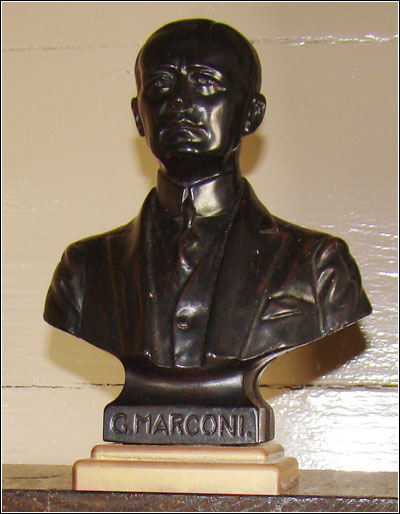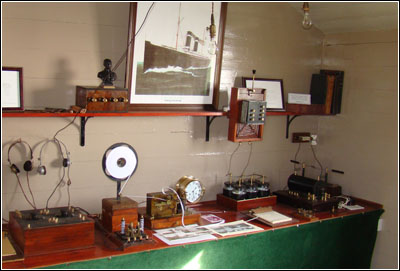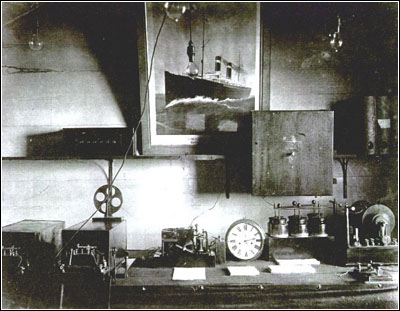Of Old Radios And Related Items--Published Monthly
The Lizard Wireless Station
The Oldest Surviving Wireless Station in the WorldBY BOBBY LYMAN
Web Edition
Even on vacation, A.R.C. staff members can't help being alert to radio-related topics along the way. Bobby Lyman and her husband made a fall 2008 hiking trip to Cornwall, England, and brought home the following story for our readers. (Editor)
In the middle of nowhere on a coastal path in Lizard, Cornwall, England, we came upon the site of the oldest surviving Marconi station in the world. This strategic location high on a coastal bluff was ideal for transmissions. The unassuming sign is shown in Figure 1 (see print version). Inside, Marconi still has a presence in the form of the small bust shown in Figure 2.
First, here is a bit of background. Marconi began his experimentation with electromagnetic radiation in 1894 at his home in Italy. His idea was to take the work of previous experimenters like James Clark Maxwell and Heinrich Hertz and make a form of practical communication without wires. By 1895, his transmission range had reached 2.4 km.
Italian authorities did not support his work, so at the age of 21, Marconi moved to a more supportive environment in Britain in 1895-1896. In 1897, Marconi formed the Wireless Telegraph and Signal Company, Ltd., to develop the equipment commercially. The range of transmission increased over the next few years, but the Navy was his only customer.
Figure 2. A bust of Marconi reminds visitors of the wireless pioneer who made radio practical.In 1900, Marconi founded the Marconi International Marine Communication Company, Ltd., to increase business. The company leased wireless telegraph equipment to ship owners and put operators on board. The plan was to build eight coastal stations to communicate with the ships, the first of which was the Lizard Wireless Station.
The Lizard Wireless Station
Built in 1900, the Lizard Wireless Station, shown in Figure 3 (see print version), consisted of two modest wood huts, one for equipment and one for living quarters, plus a 38-meter mast, the support for long wire aerials. By 1903, an electric generator and electric light had been installed, but dry batteries provided power for the equipment at first.
At the Lizard, Marconi worked to prove horizons would not be a barrier with the curved earth surface in transmissions. He developed circuit components called "jiggers" to act as filters in transmitters and receivers and to allow tuning to a desired transmitter. Before this, with receivers open on a wide frequency band, messages got garbled.
On display at the Lizard is a re-creation of the wireless station, as shown in Figure 4. A closeup of the tape register is shown in Figure 5 (see print version). Figure 6 is a 1901 photo of the equipment. Another type of detector invented by Marconi in the days of wireless -- the magnetic detector -- is shown in Figure 7 (see print version).
The Telegraph Acts of 1868 and 1869 had given the post office a monopoly on messages sent by telegraph, but wireless was not a consideration then. However, privately owned systems for personal use were allowed a loophole. Nevertheless, the post office took over the Lizard in 1908-1909. Its location gave the Lizard the first contact with ships after long voyages and 1910-1913 was a busy time. The station closed in 1913 when a new station near Land's End opened. The Lizard reopened in 1914-1918 for war-related work, but closed again in 1920. In 2001, the National Trust reopened the Lizard as an operating station, recognizing its importance in wireless history. The Lizard Station website is www.lizardwireless.org.
Figure 4. A re-creation of the Lizard wireless station.More on Early Stations
Early 1900 station equipment included the transmitter (a 10-inch induction coil with an interrupter, which produced a spark); capacitors (Leyden jars); an aerial transformer (or jigger); a coherer receiver; a Morse inker; a mast; and Earthing (buried metal plates).
Originally all Marconi stations used call signs to reflect their locations. The Lizard was LD, nearby Poldhu was PD, etc. Two letters became inadequate and Marconi stations added on an "M". Thus The Lizard station became MLD. Later post office ownership changed the call sign to GLD. Today the Amateur Radio Club at Lizard uses GB2LD for special events.
The Poldhu station, built 10 km away from the Lizard, was a high-power, large-aerial station. The two stations were connected by a telegraph wire, but did wireless transmission experimentation between themselves, working to prove that several stations might be able to operate in close proximity.
Figure 6. A 1901 photo of the original wireless station equipment.The various stations discovered problems as they began service. "SOS" was introduced in 1906 at the Berlin Wireless Telegraphy Convention. Distress signals were sent in 1908 and 1909, but no coastal stations got involved.
On April 18, 1910, the Lizard recorded and acted upon an "SOS SOS" call from the Minnehaha after it had gone aground. Communication went both ways, and a lifeboat began rescue.
The problems that surfaced included the ship's using the wrong frequency so that reception was difficult. The nearby Poldhu station was scheduled to begin news and weather broadcasts five minutes after the distress call, and communications between the Lizard and the Minnehaha were jammed during the 45-minute long broadcast. This exposed the fact that interference issues with adjacent signals had not been completely resolved.
The post office had paid a large amount for a station at Bolt Head to replace the Lizard, but the Bolt Head station heard nothing at all. Its location was not geographically as suitable as the Lizard's.
Near the Lizard station is Lloyd's Signal Station, shown in Figure 8 (see print version). Originally the Lizard received signals from merchant ships as they passed the coastal station. Lizard operators used landline telegraph to London to reassure the shippers who insured cargo with Lloyds that the ocean crossing had been successful.
Also nearby today is the Marconi Center in Poldhu Cove, open to the public. It hosts the Poldhu Amateur Radio Club and has exhibits and a video presentation. Web: www.gb2gm.org. The Porthcurno Telegraph Museum (also called the Porthcurno Museum of Submarine Telegraphy) is open year round with displays and hands on exhibits. Web: www.porthcurno.org.uk
The beautiful coastal path in Cornwall is reason enough to visit this section of England, but the connections to past telegraph history are an added bonus.
References:
Barlow, David H. The History of the Lizard Wireless Telegraph Station or Marconi's "First little miracle" (sic). Bass Point, Cornwall: The Radio Officers' Association, 2007.
The Lizard Wireless Station, pamphlet. Trevithick Trust Publishers, 2000.
Bobby (née Roberta) Lyman has been a member of the A.R.C. staff since 1987 when her next-door neighbor, John Terrey, asked her if she would like to help with his newly acquired publication. In August 1998, we published a "Staff Profile" of Bobby entitled, "Wonder Woman Works Here." She continues to live up to that description, as she multitasks both here and in her personal life, which includes tennis, bridge, and lots of travel.
|
[Free Sample] [Books, etc., For Sale] [Subscribe to A.R.C./Renew] [Classified Ads] [Auction Prices] [Event Calendar] [Links] [Home] [Issue Archives] [Book Reviews] [Subscription Information] [A.R.C. FAQ]URL = http://www.antiqueradio.com/Feb09_Lyman_Lizard.html Copyright © 1996-2009 by John V. Terrey - For personal use only. Last revised: January 26, 2009. For Customer Assistance please contact ARC@antiqueradio.com or call (866) 371-0512 toll free Pages designed/maintained by Wayward Fluffy Publications Antique Radio Classified |


